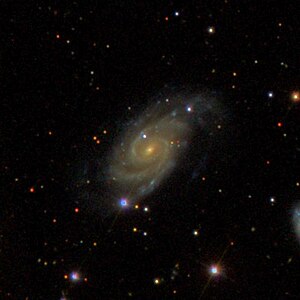NGC 477
| Galaxie NGC 477 | |
|---|---|
 | |
| SDSS-Aufnahme | |
| AladinLite | |
| Sternbild | Andromeda |
| Position Äquinoktium: J2000.0, Epoche: J2000.0 | |
| Rektaszension | 01h 21m 20,4s[1] |
| Deklination | +40° 29′ 17″[1] |
| Erscheinungsbild | |
| Morphologischer Typ | SAB(s)c / Seyfert 2[1] |
| Helligkeit (visuell) | 13,1 mag[2] |
| Helligkeit (B-Band) | 13,8 mag[2] |
| Winkelausdehnung | 1,5′ × 0,9′[2] |
| Positionswinkel | 150°[2] |
| Flächenhelligkeit | 13,3 mag/arcmin²[2] |
| Physikalische Daten | |
| Rotverschiebung | 0.019600 ± 0.000027[1] |
| Radialgeschwindigkeit | (5876 ± 8) km/s[1] |
| Hubbledistanz H0 = 73 km/(s • Mpc) | (270 ± 19) · 106 Lj (82,7 ± 5,8) Mpc [1] |
| Durchmesser | 120.000 Lj[3] |
| Geschichte | |
| Entdeckung | William Herschel |
| Entdeckungsdatum | 18. Oktober 1786 |
| Katalogbezeichnungen | |
| NGC 477 • UGC 886 • PGC 4915 • CGCG 536-032 • MCG +07-03-032 • 2MASX J01212039+4029176 • GC 268 • H III 577 • h 100 • NVSS J012121+402908 • USGC U057 NED03 | |
NGC 477 ist eine Balken-Spiralgalaxie mit aktivem Galaxienkern vom Hubble-Typ SBc im Sternbild Andromeda am Nordsternhimmel. Sie ist schätzungsweise 270 Millionen Lichtjahre von der Milchstraße entfernt und hat einen Durchmesser von etwa 115.000 Lj.
Das Objekt wurde am 18. Oktober 1786 von Wilhelm Herschel entdeckt.[4]
Weblinks
Einzelnachweise
Auf dieser Seite verwendete Medien
Autor/Urheber: Sloan Digital Sky Survey, Lizenz: CC BY 4.0
The sky image is obtained by Sloan Digital Sky Survey, DR14 with SciServer.
Angle of view: 4' × 4' (0.3" per pixel), north is up.
Details on the image processing pipeline: https://www.sdss.org/dr14/imaging/jpg-images-on-skyserver/
